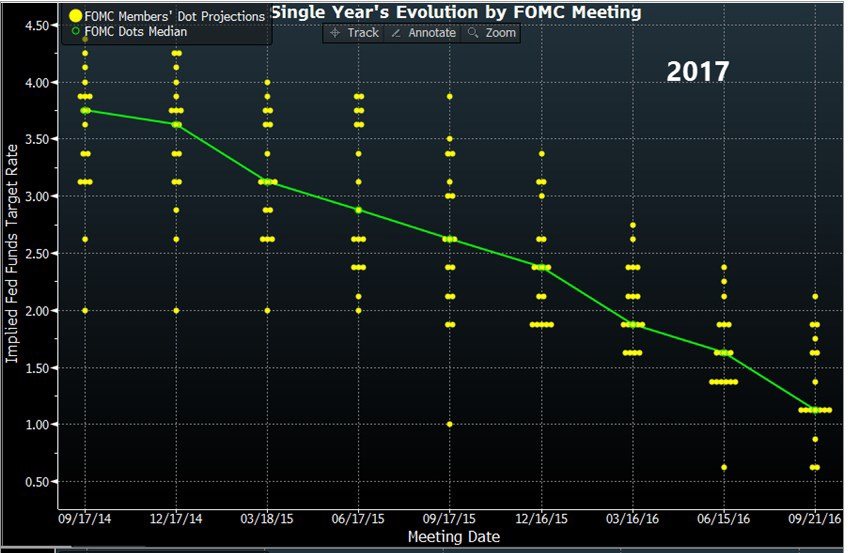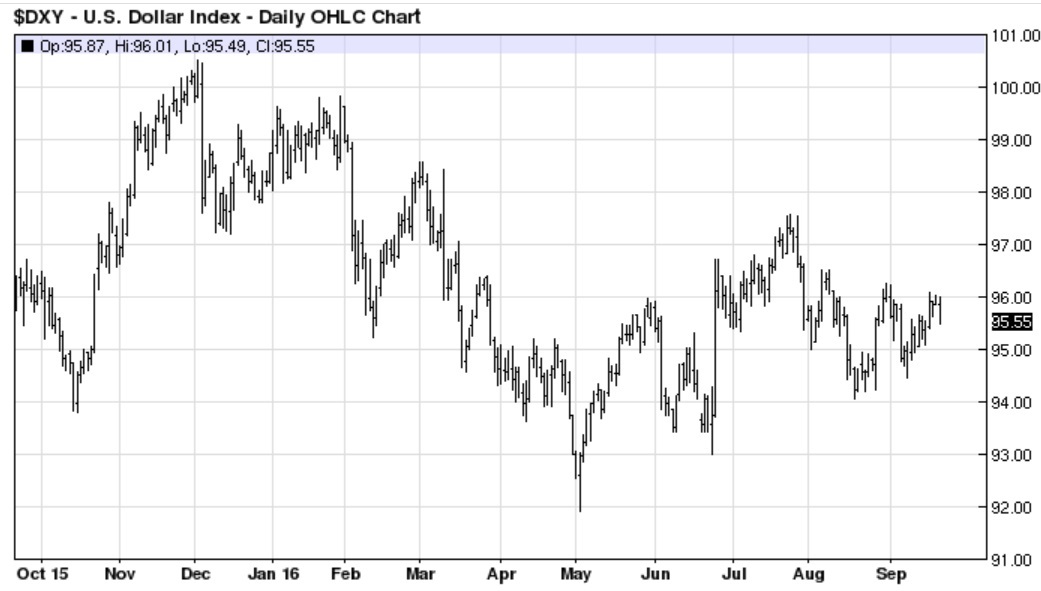Outlook:
It's hard to wrap your head around a preemptive hike projected for December when there is nothing much to prevent—inflation remains and will remain low. Waiting another couple of months is supposed to give room for the employment participation rate to improve. Well, why not wait another 12 months to get the participation rate even better? Critics think the Fed is being weaselly and saying two contradictory things. They are not entirely wrong, although the mean tone is not called for and reveals that the critics want simplicity when conditions are complicated and the Fed's position is nuanced.
On the whole, the Fed succeeded in threading a tiny needle hole. It gave the market pretty much what it wanted, right down to admitting it had over-estimated growth and thus expectations of hikes. Yellen's presentation style was exactly what was called for—yeah, we were wrong, here's the new stuff, get over it.
It's just plain wrong to say that central banks have run out of tools or that the tools they have been em-ploying didn't work. This may be mostly true of the BoJ, which has a poisonous combination of demographics, trade competition and currency. But it's not necessarily true of the Fed. If the Fed had not taken the course it did take, the US would still be mired in a recession worse than the 1930's. We don't like Fed-bashing when the Fed is one the few federal agencies that visibly does its job to the best of its ability, does it in full view of everyone (unlike, say, the FBI) and is the only independent agency, to boot.
What the critics are right about is something central banks have been saying all along—monetary policy alone cannot achieve all that we wish for. Monetary policy needs a partner—a boost from fiscal pol-icy. But the US Congress (and the German establishment) are against increasing indebtedness to pro-vide that boost. Instead of blaming the Fed because it can't walk on water, the press (and investing public) should be agitating for giving it a boat.
Trump is wrong about nearly everything, but the one thing he is right about is the desirability of cutting the US corporate tax rate to a reasonable and competitive level. Want a reversal in the productivity slump? Incentivize capital investment. The problem, of course, is that the public deficit balloons before the beneficial effects of stronger growth kick in. You don't have to be either 100% Keynesian or a sup-ply-sider to see the logic.
Yellen refrained from talking about any of this, having already said as much at Jackson Hole and on other occasions. Fiscal is not the Fed's wheelhouse. Hidden in the Fed's statements and Yellen's press remarks is the assumption that the Fed clearly does not expect a fiscal change that will promote growth. We say this shows tremendous restraint.
In fact, the Fed has been downgrading the growth outlook from 3.8% to 2.9% in just the past year alone. And the dot-plot projections have been sliding downhill proportionately. See the chart.
The Fed's growth and inflation expectations include a long, long fade-out of the effect of falling oil prices. The last inflation report showed energy costs down 9.2% y/y. We are never told whether the Fed has oil price forecasts but if they don't, they should. It is the single most important stand-alone factor in the inflation pantheon. At this point, the consensus is that the oil producers agitating for an output freeze are not going to get it, for the simple and obvious reason that it's against the self-interest of big players like Iran. In the absence of wage pressure, oil-price pressure on inflation or a fiscal boost, the Fed is right that building inflation is going to be a long, hard road.
But in the forest of gloomy outlooks, there is one bright spot—the US is now less likely than ever to entertain negative rates. And unless the 10-year slips back down under 1.60% (and it was 1.43% only last spring), we might get a steadier and sustained rise in yields. This may matter less than a few months ago but it still matters. According to Fitch Ratings reported in the FT, "The universe of nega-tive-yielding sovereign debt fell to $10.9tn as of September 12, a drop of $1tn since June 27..." If the investment-grade sovereign debt market is $38 billion, that means more than a quarter of it is negative-yielding.
"Although Japan saw a decrease over that period of $1tn to $6.9tn, it is still the largest contributor to the global total, accounting for 63 per cent of negative-yielding debt outstanding. France, Germany and Italy are the next-biggest contributors, with $1.1tn, $1tn and $500m, respectively. Of countries afflicted by negative yields, Switzerland has 95 per cent of its outstanding debt trading with a yield below zero." Yikes! This is costing investors about $500 million less per year in investment income.
The negative yielding universe is the backdrop against which to see US yields. Japan is aiming for zero in the 10-year. The ECB may have 19 10-year notes to try to herd, but the one that counts is the Bund, and it's wobbling around zero but mostly below zero. The UK has another rate decision to deliver and despite Carney's somewhat self-serving stance that the sell-off was exaggerated, it's hard to see the Gilt going up in yield. Our favorite darling, the AUD yield, is drifting lower (the "generic" 10-year at 2.034% this morning, according to Bloomberg). We have no idea whether convergence between the Australian and US 10-year yields means anything, especially given the outsized effect Down Under of China. The Reserve Bank of New Zealand hints that more easing may lie ahead, too.
It may be an old story and one that has disappointed for several years now, but divergence is still a valid theme. Which would you prefer, paying a government to store your capital or getting a return on it? And if you have a choice between two identical returns but one offers vast variety and liquidity, is there not a preference for liquidity? The US market is thousands of times bigger than the Australian.
The Fed brought back the "balance of risks" and finds them lacking anything to freak out about. Unless something horrible happens, like the US voters electing Trump, the December rate hike is pretty much a done deal. The yield curve "should" steepen. So, why is the dollar still slipping downwards this morning? We don't have a good or simple one-word explanation. Maybe it suffices to say FX always overshoots one way before it overshoots the other. And see the dollar index chart. If the index was over 100 last November/December of the outlook for rate hikes, there is a good argument it can aim for those levels again for the same reason, even if the number and pace of hikes is diluted. After all, we didn't have negative rates (except for Switzerland) last fall.
It may be clutching at straws to see an imminent uptrend in the dollar, especially because dollar-favorable scenarios have failed so often in the past. But it has the virtue of logic, as long as the creek don't rise.
| Current | Signal | Signal | Signal | |||
| Currency | Spot | Position | Strength | Date | Rate | Gain/Loss |
| USD/JPY | 100.67 | SHORT USD | NEW*STRONG | 09/22/16 | 100.67 | 0.00% |
| GBP/USD | 1.3080 | SHORT GBP | STRONG | 09/10/16 | 1.3041 | -0.30% |
| EUR/USD | 1.1245 | SHORT EUR | WEAK | 09/19/16 | 1.1168 | -0.69% |
| EUR/JPY | 113.20 | SHORT EURO | NEW*WEAK | 09/22/16 | 113.20 | 0.00% |
| EUR/GBP | 0.8598 | LONG EURO | WEAK | 09/19/16 | 0.8564 | 0.40% |
| USD/CHF | 0.9691 | LONG USD | WEAK | 09/19/16 | 0.9804 | -1.15% |
| USD/CAD | 1.3030 | LONG USD | WEAK | 09/15/16 | 1.3203 | -1.31% |
| NZD/USD | 0.7337 | SHORT NZD | WEAK | 09/19/16 | 0.7305 | -0.44% |
| AUD/USD | 0.7666 | LONG AUD | NEW*WEAK | 09/22/16 | 0.7666 | 0.00% |
| AUD/JPY | 77.18 | SHORT AUD | WEAK | 09/05/16 | 78.90 | 2.18% |
| USD/MXN | 19.6310 | LONG USD | STRONG | 05/06/16 | 17.9418 | 9.41% |
This morning FX briefing is an information service, not a trading system. All trade recommendations are included in the afternoon report.
Recommended Content
Editors’ Picks
AUD/USD remained bid above 0.6500

AUD/USD extended further its bullish performance, advancing for the fourth session in a row on Thursday, although a sustainable breakout of the key 200-day SMA at 0.6526 still remain elusive.
EUR/USD faces a minor resistance near at 1.0750

EUR/USD quickly left behind Wednesday’s small downtick and resumed its uptrend north of 1.0700 the figure, always on the back of the persistent sell-off in the US Dollar ahead of key PCE data on Friday.
Gold holds around $2,330 after dismal US data

Gold fell below $2,320 in the early American session as US yields shot higher after the data showed a significant increase in the US GDP price deflator in Q1. With safe-haven flows dominating the markets, however, XAU/USD reversed its direction and rose above $2,340.
Bitcoin price continues to get rejected from $65K resistance as SEC delays decision on spot BTC ETF options

Bitcoin (BTC) price has markets in disarray, provoking a broader market crash as it slumped to the $62,000 range on Thursday. Meanwhile, reverberations from spot BTC exchange-traded funds (ETFs) continue to influence the market.
US economy: slower growth with stronger inflation

The dollar strengthened, and stocks fell after statistical data from the US. The focus was on the preliminary estimate of GDP for the first quarter. Annualised quarterly growth came in at just 1.6%, down from the 2.5% and 3.4% previously forecast.

